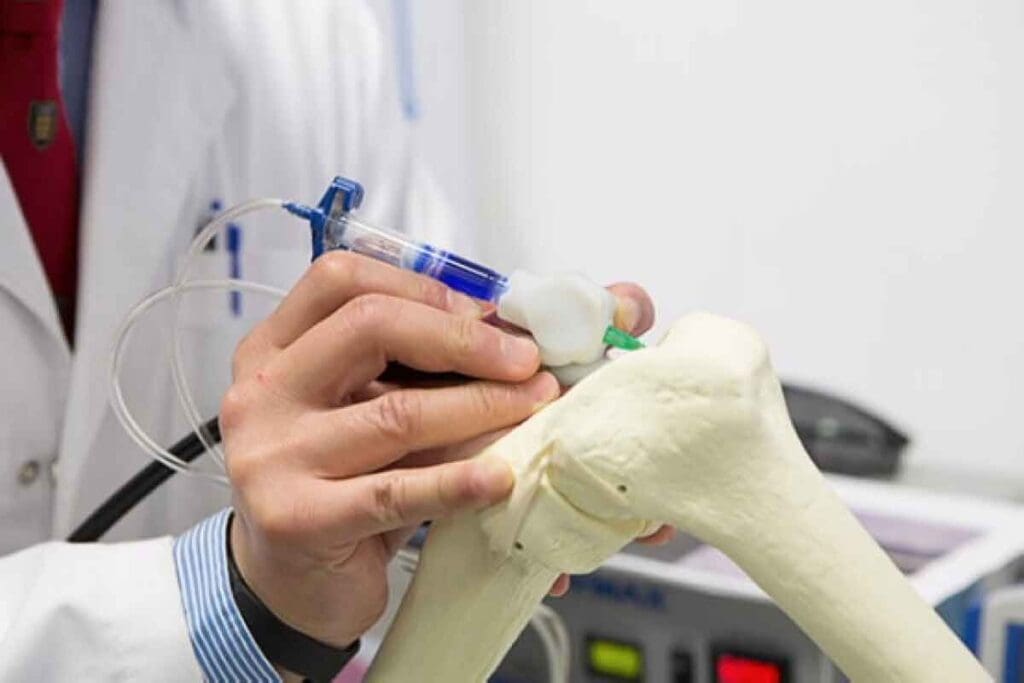Last Updated on November 17, 2025 by Ugurkan Demir

Recovering from a bone marrow transplant is tough and takes time. At Liv Hospital, we know how important post BMT care is for a good recovery.
Bone marrow transplants replace bad bone marrow with healthy stem cells. This helps the body make healthy blood cells again. Our team offers top-notch support at every step of the post BMT care and bone marrow transplant recovery timeline.
It’s key for patients and their families to understand the recovery process. We explain the main steps of the recovery after bone marrow transplant. This helps them know what to expect.

The journey of bone marrow transplantation is more than just the procedure. It also includes a detailed recovery process. Bone marrow transplant recovery is different for everyone.
Bone marrow transplants fall into two main types: autologous and allogeneic. Autologous transplants use the patient’s own stem cells. These cells are collected, stored, and then reinfused after a conditioning regimen. This method is often used for certain lymphomas and multiple myeloma.
Allogeneic transplants use stem cells from a donor. The donor can be a relative or someone unrelated. The success of the transplant depends on how well the donor’s cells match the patient’s. Allogeneic transplants are used for a wider range of diseases, like leukemia and genetic disorders.
The bone marrow transplant recovery time depends on several factors. These include the type of transplant, the patient’s health, and any complications. For example, autologous transplants usually have a shorter recovery time than allogeneic transplants.
Knowing what affects recovery from bone marrow transplant helps set realistic goals. Patients can expect the initial recovery to last several weeks to a few months. Engraftment usually happens within 2 to 6 weeks after the transplant.
It’s important for patients and their caregivers to understand the recovery process. Knowing the challenges and milestones helps prepare for the journey. It also helps in seeking the right support when needed.

Post-BMT care includes many important parts to help patients recover. It’s a team effort to meet the complex needs of patients. This care is vital for a smooth recovery after a bone marrow transplant.
A well-coordinated medical team is key for post-BMT care. This team usually has:
Patients need special care to handle the risks of bone marrow transplants. This includes:
Teaching patients and their caregivers is a big part of post-BMT care. This education covers:
By focusing on these key areas, healthcare teams can give thorough post-BMT care. This care helps patients and their caregivers through the recovery journey.
The first few weeks after a bone marrow transplant are very important. Doctors watch closely for any problems. They also teach patients how to take care of themselves.
When patients are ready to go home, they must meet certain criteria. They need to have a working graft and no major health issues. They also must be able to take care of themselves at home.
Key discharge criteria include:
After a bone marrow transplant, it’s vital to take medications as directed. These drugs help prevent problems and ensure the transplant works. Patients usually take immunosuppressants, antibiotics, and other supportive medicines.
It’s essential for patients to adhere strictly to their medication schedules and to report any side effects or concerns to their healthcare team.
Keeping infections away is a big part of post-BMT care. Patients are more likely to get sick because their immune systems are weak. So, they must follow strict rules to avoid infections.
“Preventing infections is a top priority in the first 30 days after a bone marrow transplant. Patients should avoid crowded areas, practice good hygiene, and follow their healthcare team’s guidance on infection prevention.”
-Experts advise.
By managing hospital discharge, medication, and infection prevention well, patients can have a better chance of recovering from BMT.
The engraftment period is a key time after a transplant, lasting 2 to 6 weeks. It’s when the new bone marrow starts making blood cells. This is a big step in getting better after a bone marrow transplant.
When new blood cells start being made, it shows the transplant is working. We check these levels with blood tests. Seeing these counts go up is a good sign.
Key indicators of successful engraftment include:
Even though engraftment is a good thing, it can come with problems. We watch for graft-versus-host disease (GVHD), infections, and graft failure. Catching these early is key to managing them.
| Complication | Symptoms | Management |
| Graft-versus-Host Disease (GVHD) | Rash, liver dysfunction, gastrointestinal symptoms | Immunosuppressive medications, close monitoring |
| Infection | Fever, chills, fatigue | Antibiotics, antiviral medications, and isolation protocols |
| Graft Failure | Persistent low blood cell counts | Growth factors, possible second transplant |
Nutrition is very important during engraftment. Eating foods high in protein, vitamins, and minerals helps recovery. We suggest patients talk to a nutritionist for a meal plan that fits their needs.
By focusing on nutrition and watching for problems, we help ensure a good engraftment. This makes the recovery smoother for our patients.
Between 30 to 100 days after the transplant, patients enter the early recovery phase. This is a critical period where significant milestones are achieved and challenges are addressed.
During this phase, patients are closely monitored for various complications. Rehabilitation efforts begin to gain momentum. We will outline the key aspects of this phase, including the milestones achieved around 60 days post-transplant, the monitoring for acute graft-versus-host disease, and the beginnings of physical rehabilitation.
Reaching the 60-day mark after a bone marrow transplant is a significant milestone. At this point, patients have typically undergone substantial recovery. Their medical team closely monitors their progress. Key milestones at this stage include:
These milestones are critical indicators of the patient’s recovery trajectory. It’s essential to continue monitoring for complications, such as infections and graft-versus-host disease.
Acute graft-versus-host disease (aGVHD) is a significant concern during the early recovery phase. aGVHD occurs when the donor immune cells attack the recipient’s tissues. We closely monitor patients for signs of aGVHD, which can include:
Prompt identification and management of aGVHD are critical. They prevent its progression and ensure the patient’s comfort and safety.
Physical rehabilitation is a vital component of the early recovery phase. Gentle exercises and physical therapy help patients regain strength. They improve mobility and enhance overall well-being. We encourage patients to:
By incorporating physical rehabilitation into their recovery plan, patients can better manage fatigue. They reduce the risk of complications and improve their quality of life.
After the first 100 days post-BMT, patients enter a key recovery phase. This period, from 100 days to 6 months, sees major health and immune system rebuilding.
The immune system rebuilds slowly, taking up to a year after the transplant. Patients need to know this. We watch for signs of immune recovery, like normal blood cell counts and no infections.
Important parts of immune rebuilding include:
With a stronger immune system, we start the vaccination schedule again. Re-vaccination is key to protecting against infections. The vaccines and schedule depend on the patient’s health and transplant type.
Vaccines often given during this time include:
As health improves, patients start doing normal activities again. This means going back to work, exercising, and socializing. It’s important to listen to your body and not push too hard.
Getting back to normal also means:
In the intermediate recovery phase, we closely watch patients’ progress. We help with any issues and guide them on safely getting back to their lives. This phase is a big step towards full recovery and independence after a bone marrow transplant.
After the first intense phases of bone marrow transplant recovery, patients start a new stage: long-term recovery. This stage lasts from six months to one year after the transplant. It’s key for healing, adjusting, and watching for possible complications.
During this time, patients need to watch for chronic problems like graft-versus-host disease (GVHD), infections, or organ damage. Regular visits with the healthcare team are essential for catching these issues early.
Monitoring for chronic GVHD is very important. It can harm different organs and tissues, causing serious health problems. Our team closely watches for GVHD signs and starts the right treatment plans.
Recovery isn’t just about getting better physically; it’s also about psychological adjustment. Patients might feel many emotions, from happiness and relief to sadness and worry. It’s important to offer psychological support during this time.
Our team stresses the need for psychological support. We offer counseling, support groups, and resources to help patients deal with their feelings. This way, we make sure patients get care that covers their physical and emotional needs.
It’s important to remember that recovery times can differ a lot between patients. Things like the transplant type, health before the transplant, and any complications can affect how fast someone recovers.
Our healthcare providers work with patients to understand their unique recovery paths. We tailor support and care to fit their needs. This approach helps improve outcomes and quality of life for patients in the long run.
Life after a bone marrow transplant is a journey of recovery and learning. Patients have usually passed the tough start of the transplant. Now, they focus on staying healthy for the long term.
We suggest a follow-up plan to keep an eye on patients’ health. This plan includes regular visits with the healthcare team.
Screening for secondary cancers is key in long-term care. We teach patients about these screenings. We help them create a plan that fits their needs.
Quality of life matters a lot after a bone marrow transplant. We help patients make lifestyle changes. This includes eating right, exercising, and managing stress.
| Aspect of Care | Recommendations | Frequency |
| Follow-up Visits | Regular check-ups with the healthcare team | Every 3-6 months |
| Secondary Cancer Screening | Personalized screening plan | Annually or as recommended |
| Lifestyle Adjustments | Dietary changes, exercise, and stress management | Ongoing |
Managing transplant failure is key to bone marrow transplant recovery. Many patients worry about rejection or failure. Knowing the warning signs and what to do next can greatly help.
Transplant rejection happens when the immune system sees the new marrow as foreign. It’s important to spot these signs early. Some common signs include:
Regular check-ups with your doctor are vital to watch the new marrow’s health.
If a transplant fails, we look at other treatments. The next steps depend on why it failed and your health. Some options are:
We help patients choose the best path based on their situation.
For those facing transplant failure, new treatments offer hope. These might include:
Second, bone marrow transplants are also an option. We discuss the risks and benefits with patients carefully.
In summary, managing transplant failure needs careful watching and quick action. We’re here to support our patients every step of the way.
Bone marrow donation is a kind act that needs an understanding of the recovery process. This ensures the health of the donor. The journey of bone marrow donors is different from that of the recipients.
Donors usually get back to normal in a few weeks. The exact time depends on the donor’s health and the donation method.
Donors might feel tired, have back pain, or bruising after donation. These symptoms are usually managed with rest, pain meds, and follow-up care.
Bone marrow donors usually recover faster than recipients. Donors mainly need to get over the donation procedure. Recipients, on the other hand, face a long transplant process.
| Aspect | Bone Marrow Donor | Bone Marrow Recipient |
| Recovery Time | Few weeks | Several months to a year or more |
| Common Challenges | Fatigue, back pain, bruising | Graft-versus-host disease, infections, organ toxicity |
| Follow-up Care | Short-term follow-up, pain management | Long-term follow-up, immunosuppression management |
Knowing these differences is key for donors and recipients to have realistic recovery expectations.
Going through a bone marrow transplant is a big challenge. Patients and their families get help from healthcare teams. They guide them through the tough times and important steps of recovery.
It’s key to know how to care for yourself after a BMT. By managing your recovery and adjusting to life post-transplant, you can beat the treatment’s hurdles.
We offer top-notch healthcare and support for international patients. Our team is here to help you through your transplant journey. We aim to make sure you get the care and support you need for a good recovery and a better life after the transplant.
Recovery time after a bone marrow transplant varies. It depends on individual factors and the transplant type. It can take several months to a year or more for the immune system to fully recover.
Common complications include graft-versus-host disease, infections, and graft failure. It’s important for the medical team to closely monitor during this phase.
The immune system starts to recover around 100 days to 6 months after the transplant. Vaccinations are restarted to protect against infections.
Warning signs include a decrease in blood counts, fever, and symptoms of graft failure. Patients are closely monitored for these signs. Prompt action is taken if complications arise.
Bone marrow donors recover faster than transplant recipients. They usually recover within a few weeks. Some may experience fatigue or other symptoms for a longer period.
The recovery timeline includes several phases. These are the immediate post-transplant phase, engraftment period, early recovery phase, intermediate recovery, long-term recovery, and life after the transplant.
Effective post BMT care involves a well-coordinated medical team. It also requires specialized care and thorough education for patients and caregivers.
60 days after, patients are monitored for complications like acute graft-versus-host disease. Physical rehabilitation starts to help regain strength.
Yes, a bone marrow transplant can fail. Patients who experience failure are guided through alternative therapies. The possibility of second transplants is also discussed.
Life after a transplant involves long-term follow-up. This is to monitor for complications and assess quality of life. Patients are supported in making lifestyle adjustments to optimize their recovery and overall health.
Subscribe to our e-newsletter to stay informed about the latest innovations in the world of health and exclusive offers!